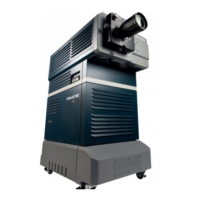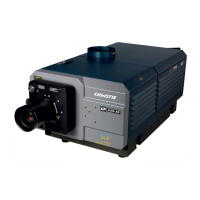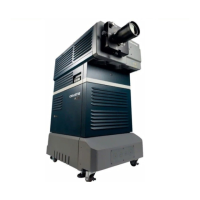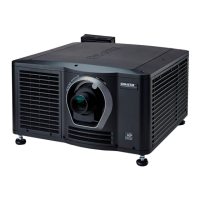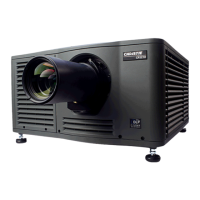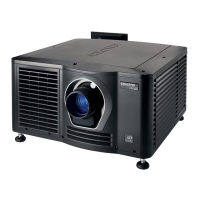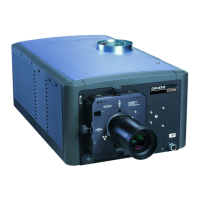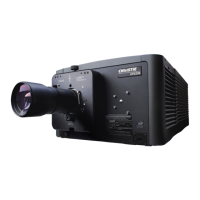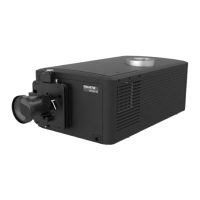Do you have a question about the Christie CP2000-M and is the answer not in the manual?
Information regarding FCC compliance and digital apparatus.
Details limitations of Christie's limited warranty.
Importance of continued maintenance to avoid voiding the warranty.
Explains how to use the manual and its structure.
Explains danger, warning, and caution symbols used in the manual.
Defines formatting conventions like bold, italics, Courier font used in the manual.
Provides information on recording purchase details and contacting service.
Provides a general overview of the CP2000-M/MR projector.
Explains the technical principles behind the projector's operation.
Describes the Control Display Panel (CDP) and web user interface.
Lists the expected components received with the projector.
Lists the main features and capabilities of the CP2000-M/MR projector.
Details the steps for installing the projector.
Instructions on how to position the projector for optimal viewing.
Describes how to install the projector on an optional rack stand.
Instructions for mounting the Control Display Panel (CDP).
Explains how to connect optional exhaust ducting for ventilation.
Step-by-step guide for installing the projector lens.
Instructions for installing the optional motorized auxiliary lens mount.
Details on installing and adjusting an anamorphic lens.
Instructions for adding and adjusting a wide converter lens.
Procedure for installing the projector lamp, including safety precautions.
Steps for connecting the projector to a power source.
Guide for connecting sources and performing the initial power-up sequence.
Explains how to connect external sources to the projector.
Details on connecting for serial and Ethernet communications.
Procedures for adjusting the projector's tilt and leveling.
How to adjust settings for optimal light output.
Procedure for adjusting screen brightness using the web interface.
Steps for performing basic image alignment.
Instructions for adjusting lens mount offset and boresight.
Detailed steps for adjusting lens mount boresight.
Procedures for adjusting fold mirror and convergence.
Overview of system calibration procedures.
Detailed steps for calibrating the projector's color performance.
How to use electronic screen masking for image cropping.
Explains the use of Projector Configuration Files (PCFs).
Identifies and describes the main projector components.
Information on the air filter, its maintenance, and replacement.
Details about the Control Display Panel (CDP) and its functions.
Explains the function of the douser for picture muting.
Information on connecting and using the optional exhaust duct.
How to adjust the projector's leveling feet.
Information about the projector lamp and its specifications.
Describes the lens mount and optional auxiliary lens mount.
Details the security locks protecting projector components.
Describes the signal input and communication ports on the projector.
Step-by-step guide for powering up the projector.
Steps to properly power down the projector.
Explains the different power states of the projector.
Guide on how to operate the projector using the CDP.
Details the functions of each key on the CDP.
Lists the various functions controllable via the CDP.
Provides best practices for operating the CDP.
Explains how to navigate through the CDP menus.
Describes the meaning of various icons used in the CDP display.
How to use the Channel menu to manage sources and settings.
Controls for optimizing lamp alignment and power.
Menu for adjusting lens focus, zoom, and offsets.
Procedure for calibrating the projector's lenses.
Overview of the Status menu for checking projector status.
Controls for adjusting settings and running diagnostics.
How to select and use test patterns for setup and troubleshooting.
Guide to controlling the projector via a web interface.
Explains user security levels and access rights for the web UI.
How to navigate the web user interface.
Overview of the main menu within the web user interface.
Controls for the Intelligent Lens System (ILS) via the web UI.
Accessing system status information via the web UI.
How alarm conditions are displayed and acknowledged.
Displays projector serial number, software level, and hardware components.
Password-protected access to tailor projector processing for sources.
Controls for adjusting and synchronizing incoming 3D signals.
Maintains consistent light output (LiteLOC™) or sets lamp power.
Modifies ILS settings for a particular channel.
Access to advanced system parameters, test patterns, and user settings.
Access to various system preference parameters.
Controls for lamp alignment and light output maintenance.
Adjusting lamp position for optimized optical system.
Displays recorded lamp serial numbers and logged hours.
Setup for primary lens, auxiliary lens, MALM, and ILS.
Management of users, passwords, and user access rights.
Options for defining projector response to sources and system parameters.
Defining projector response to incoming source resolutions and aspect ratios.
Defining display portion and cropping for geometric aberrations.
Recording projector's uncorrected color performance for calibration.
Modifying or creating custom Target Color Gamut Data (TCGD) files.
Defining or changing Ethernet settings and network addresses.
Options for system backups and site-specific parameters.
Recording min/max footlambert readings for lamp calibration.
Optimizing lamp performance and brightness.
Instructions to turn the lamp on/off via the web UI.
How to adjust lamp power and brightness levels.
Procedures for adjusting lamp position for optimal performance.
Information on lamp age, replacement, and rotation.
Adjustments for boresight, focus, zoom, and offsets.
Displaying 3D images requires specific source and hardware.
Lists necessary components and setups for 3D display.
Step-by-step guide for setting up 3D display.
Troubleshooting common 3D display issues.
How trained operators use the projector for cinema events.
Lists compatible cinema sources and connections.
Explains flat and scope aspect ratios for cinema displays.
How to use an anamorphic lens for scope image formats.
Using a wide converter lens for scope images without resizing.
How theaters use masking to conceal unused screen edges.
Displaying alternative content from non-cinema sources like PCs.
How to select non-cinema sources and return to cinema sources.
Visual representation of the CDP menu structure.
General safety precautions for operating the projector.
Key safety warnings regarding UV and fire hazards.
Critical safety warnings related to lamp handling and explosion hazards.
Recommended protective clothing for servicing the projector.
Instructions to cool the lamp before handling to prevent injury.
Importance of checking and maintaining the cooling system.
Guidelines for projector ventilation and clearance.
Information on checking and replacing the air filter.
Details on the liquid cooler system and coolant.
Steps for filling the liquid cooler reservoir.
Checking the optional exhaust duct for cleanliness and obstructions.
General guidelines for projector maintenance and cleaning.
Maintenance checks for the projector lamp connections.
Precautions and guidelines for cleaning optical components.
Procedures for cleaning the projector lens to avoid scratches.
Instructions for cleaning the lamp reflector.
Maintenance checks for components like lamp fans.
Detailed procedure for replacing the projector lamp.
Instructions for replacing the projector's air filter.
Step-by-step guide for changing the projector lens.
Troubleshooting power issues, such as the projector not powering on.
Steps to troubleshoot when the lamp fails to ignite.
Troubleshooting steps for when the lamp turns off unexpectedly.
Troubleshooting flickering, shadows, or dimness issues.
Troubleshooting LampLOC™ functionality.
Troubleshooting LiteLOC™ functionality.
Troubleshooting for the Intelligent Lens System (ILS).
Troubleshooting issues related to the Control Display Panel (CDP).
Steps to troubleshoot when the CDP has no light.
Troubleshooting Ethernet connectivity issues.
Troubleshooting cinema display issues.
Troubleshooting steps for a blank screen or no cinema image.
Troubleshooting severe motion artifacts in cinema displays.
Troubleshooting vertically stretched or squeezed images.
Troubleshooting scenarios with no image or pink snow.
Troubleshooting issues with non-cinema displays.
Troubleshooting steps when the projector is on but shows no display.
Troubleshooting jittery or unstable non-cinema displays.
Troubleshooting faint displays.
Troubleshooting waving, tearing, or jittering in display upper portions.
Troubleshooting display portions cut off or warped.
Troubleshooting compressed or vertically stretched displays.
Troubleshooting when data is cropped from image edges.
Troubleshooting display quality that drifts over time.
Troubleshooting when the display suddenly freezes.
Troubleshooting inaccurate display colors.
Troubleshooting non-rectangular display shapes.
Troubleshooting noisy or grainy display images.
Troubleshooting random streaks on the bottom of the image.
Technical specifications related to the projector's display capabilities.
Specifies panel resolution and supported refresh rates.
Details the achievable brightness levels with different lamps.
Specifies the minimum contrast ratio of the projector.
Details luminance uniformity specifications.
Specifies displayable colors and gray scale resolution.
Specifies the white point coordinates for calibration.
Details the gamma specifications for theater and review rooms.
Specifies the axial focus range.
Details the usable range for lens offsets.
Specifications for the D-Cinema ports.
Specifications for the DVI-D graphic ports.
Compatibility details for various control signal interfaces.
Specifications for the Ethernet management ports.
Specifications for the Ethernet auxiliary port.
Specifications for the RS232-A port.
Specifications for the RS232-B port.
Specifications for the GPIO port.
Specifications for the SCCI port.
Specifications for the Control Display Panel (CDP).
Details on power requirements for standard and UPS modes.
Specifications for the projector lamps (CDXL-20SD and CDXL-18SD).
Dimensions, weight, and operational position specifications.
Conformance to safety, environmental, and EMC regulations.
Operating and non-operating environment specifications.
Lists standard and optional components included with the projector.
Controls device address on ASCII Protocol network for RS-232.
Controls the motorized auxiliary lens (anamorphic or converter).
Controls system backups, including configuration and user files.
Sets the baud rate for serial communications ports.
Controls CDP settings like backlight and contrast.
Selects channel configuration for input routing and image processing.
Sets the icon file name and path for channel display on web UI.
Controls source colorimetry by setting color space files.
Resets all preference and configuration settings to default values.
Sets the data logging level for the projector.
Selects data packing format for selected input ports.
Enables or disables error message broadcasting.
Adjusts focus lens to a specific position.
Controls gamma response curve for the source signal.
Enables or disables the Intelligent Lens System for a channel.
Lists and selects internal test patterns for setup and troubleshooting.
Calibrates intensity feedback mechanism to footlamberts.
Resets lens mount system to home position.
Sets the Look Up Table (LUT) Color Look Up Table (CLUT) file.
Defines model and serial number for primary and auxiliary lenses.
Adjusts lens to a specific horizontal position.
Sets or gets lamp type (ID) for the currently installed lamp.
Allows adjustment of lamp position for optimized optical system.
Enables/disables Lens Manual Operation mode.
Adjusts all lens position parameters simultaneously.
Sets localization options like language and temperature units.
Records current lamp info into history and starts a new entry.
Reads control for information on installed lamps.
Sets lamp intensity set point for LiteLOC™.
Sets or gets expected lamp life in hours.
Sets lamp mode to constant power or LiteLOC™ for global/per channel.
Sets lamp power to be used in Constant Power Mode.
Adjusts lens to a specific vertical position.
Selects the Measured Color Gamut file for color processing.
Sets the descriptive channel name for the specified channel.
Sets or requests network setup for the device.
Calibrates lens mount system and performs motor backlash calculations.
Sets PCF file for channel configuration of cinema electronics.
Selects whether to use the PCF file or not.
Returns basic projector information like device type and software version.
Controls whether lamp power settings are per channel or global.
Selects cinema processing mode for extended pixel depth and color processing.
Changes the power state of the projector (standby, on, cool down).
Sets remote serial protocol access level for communications ports.
Selects screen format file describing output image geometry.
Opens or closes the projector shutter/douser.
Selects input port, resetting DTF control data.
Sets configuration options for the SNMP Agent.
Sets screen orientation for various mounting options.
Selects the source format file.
Retrieves various system status groups.
Sets the Target Color Gamut file for desired output colorimetry.
Enables or disables 3D on a specified channel.
Sets Display Reference GPI for 3D control and synchronization.
Sets dark time for 3D control to synchronize glasses.
Sets output reference delay phase for 3D control.
Sets display reference timing signal for 3D control.
Sets output reference delay time for 3D control.
Selects which signal is considered first in source for 3D control.
Sets frame rate multiple for 3D control.
Sets input reference general purpose input for 3D synchronization.
Sets input timing reference for 3D control.
Sets the projector's time zone.
Sets Display Reference GPO for 3D control.
Sets output timing signal reference polarity for 3D control.
Logs in a username with a password or queries the current logged level.
Pin configuration for SMPTE-292M ports (A and B).
Pin configuration for DVI-D ports.
Pin configuration for Ethernet management and auxiliary ports.
Pin configuration for the RS232-A port.
Pin configuration for the RS232-B port.
Pin configuration for the SCCI port.
Pin configuration for the GPIO port.
Explains how to use a GPIO link for external equipment, like 3D synchronizing.
Lists CDP error codes related to interlocks.
Lists CDP error codes related to fan speeds.
Lists CDP error codes related to low voltage power supply.
Lists CDP error codes related to the ballast.
Lists CDP error codes related to lamp operation.
Lists CDP error codes related to system self-tests.
Lists CDP error codes related to TI State.
Procedure to restore lens mount to a working condition as a last resort.
Steps to set up for boresight adjustment.
How to establish the initial boresight starting position.
Steps to center the zoom and focus ring for nominal position.
Procedures to begin the boresight correction process.
How to confirm focus across the entire zoom range.
Information regarding FCC compliance and digital apparatus.
Details limitations of Christie's limited warranty.
Importance of continued maintenance to avoid voiding the warranty.
Explains how to use the manual and its structure.
Explains danger, warning, and caution symbols used in the manual.
Defines formatting conventions like bold, italics, Courier font used in the manual.
Provides information on recording purchase details and contacting service.
Provides a general overview of the CP2000-M/MR projector.
Explains the technical principles behind the projector's operation.
Describes the Control Display Panel (CDP) and web user interface.
Lists the expected components received with the projector.
Lists the main features and capabilities of the CP2000-M/MR projector.
Details the steps for installing the projector.
Instructions on how to position the projector for optimal viewing.
Describes how to install the projector on an optional rack stand.
Instructions for mounting the Control Display Panel (CDP).
Explains how to connect optional exhaust ducting for ventilation.
Step-by-step guide for installing the projector lens.
Instructions for installing the optional motorized auxiliary lens mount.
Details on installing and adjusting an anamorphic lens.
Instructions for adding and adjusting a wide converter lens.
Procedure for installing the projector lamp, including safety precautions.
Steps for connecting the projector to a power source.
Guide for connecting sources and performing the initial power-up sequence.
Explains how to connect external sources to the projector.
Details on connecting for serial and Ethernet communications.
Procedures for adjusting the projector's tilt and leveling.
How to adjust settings for optimal light output.
Procedure for adjusting screen brightness using the web interface.
Steps for performing basic image alignment.
Instructions for adjusting lens mount offset and boresight.
Detailed steps for adjusting lens mount boresight.
Procedures for adjusting fold mirror and convergence.
Overview of system calibration procedures.
Detailed steps for calibrating the projector's color performance.
How to use electronic screen masking for image cropping.
Explains the use of Projector Configuration Files (PCFs).
Identifies and describes the main projector components.
Information on the air filter, its maintenance, and replacement.
Details about the Control Display Panel (CDP) and its functions.
Explains the function of the douser for picture muting.
Information on connecting and using the optional exhaust duct.
How to adjust the projector's leveling feet.
Information about the projector lamp and its specifications.
Describes the lens mount and optional auxiliary lens mount.
Details the security locks protecting projector components.
Describes the signal input and communication ports on the projector.
Step-by-step guide for powering up the projector.
Steps to properly power down the projector.
Explains the different power states of the projector.
Guide on how to operate the projector using the CDP.
Details the functions of each key on the CDP.
Lists the various functions controllable via the CDP.
Provides best practices for operating the CDP.
Explains how to navigate through the CDP menus.
Describes the meaning of various icons used in the CDP display.
How to use the Channel menu to manage sources and settings.
Controls for optimizing lamp alignment and power.
Menu for adjusting lens focus, zoom, and offsets.
Procedure for calibrating the projector's lenses.
Overview of the Status menu for checking projector status.
Controls for adjusting settings and running diagnostics.
How to select and use test patterns for setup and troubleshooting.
Guide to controlling the projector via a web interface.
Explains user security levels and access rights for the web UI.
How to navigate the web user interface.
Overview of the main menu within the web user interface.
Controls for the Intelligent Lens System (ILS) via the web UI.
Accessing system status information via the web UI.
How alarm conditions are displayed and acknowledged.
Displays projector serial number, software level, and hardware components.
Password-protected access to tailor projector processing for sources.
Controls for adjusting and synchronizing incoming 3D signals.
Maintains consistent light output (LiteLOC™) or sets lamp power.
Modifies ILS settings for a particular channel.
Access to advanced system parameters, test patterns, and user settings.
Access to various system preference parameters.
Controls for lamp alignment and light output maintenance.
Adjusting lamp position for optimized optical system.
Displays recorded lamp serial numbers and logged hours.
Setup for primary lens, auxiliary lens, MALM, and ILS.
Management of users, passwords, and user access rights.
Options for defining projector response to sources and system parameters.
Defining projector response to incoming source resolutions and aspect ratios.
Defining display portion and cropping for geometric aberrations.
Recording projector's uncorrected color performance for calibration.
Modifying or creating custom Target Color Gamut Data (TCGD) files.
Defining or changing Ethernet settings and network addresses.
Options for system backups and site-specific parameters.
Recording min/max footlambert readings for lamp calibration.
Optimizing lamp performance and brightness.
Instructions to turn the lamp on/off via the web UI.
How to adjust lamp power and brightness levels.
Procedures for adjusting lamp position for optimal performance.
Information on lamp age, replacement, and rotation.
Adjustments for boresight, focus, zoom, and offsets.
Displaying 3D images requires specific source and hardware.
Lists necessary components and setups for 3D display.
Step-by-step guide for setting up 3D display.
Troubleshooting common 3D display issues.
How trained operators use the projector for cinema events.
Lists compatible cinema sources and connections.
Explains flat and scope aspect ratios for cinema displays.
How to use an anamorphic lens for scope image formats.
Using a wide converter lens for scope images without resizing.
How theaters use masking to conceal unused screen edges.
Displaying alternative content from non-cinema sources like PCs.
How to select non-cinema sources and return to cinema sources.
Visual representation of the CDP menu structure.
General safety precautions for operating the projector.
Key safety warnings regarding UV and fire hazards.
Critical safety warnings related to lamp handling and explosion hazards.
Recommended protective clothing for servicing the projector.
Instructions to cool the lamp before handling to prevent injury.
Importance of checking and maintaining the cooling system.
Guidelines for projector ventilation and clearance.
Information on checking and replacing the air filter.
Details on the liquid cooler system and coolant.
Steps for filling the liquid cooler reservoir.
Checking the optional exhaust duct for cleanliness and obstructions.
General guidelines for projector maintenance and cleaning.
Maintenance checks for the projector lamp connections.
Precautions and guidelines for cleaning optical components.
Procedures for cleaning the projector lens to avoid scratches.
Instructions for cleaning the lamp reflector.
Maintenance checks for components like lamp fans.
Detailed procedure for replacing the projector lamp.
Instructions for replacing the projector's air filter.
Step-by-step guide for changing the projector lens.
Troubleshooting power issues, such as the projector not powering on.
Steps to troubleshoot when the lamp fails to ignite.
Troubleshooting steps for when the lamp turns off unexpectedly.
Troubleshooting flickering, shadows, or dimness issues.
Troubleshooting LampLOC™ functionality.
Troubleshooting LiteLOC™ functionality.
Troubleshooting for the Intelligent Lens System (ILS).
Troubleshooting issues related to the Control Display Panel (CDP).
Steps to troubleshoot when the CDP has no light.
Troubleshooting Ethernet connectivity issues.
Troubleshooting cinema display issues.
Troubleshooting steps for a blank screen or no cinema image.
Troubleshooting severe motion artifacts in cinema displays.
Troubleshooting vertically stretched or squeezed images.
Troubleshooting scenarios with no image or pink snow.
Troubleshooting issues with non-cinema displays.
Troubleshooting steps when the projector is on but shows no display.
Troubleshooting jittery or unstable non-cinema displays.
Troubleshooting faint displays.
Troubleshooting waving, tearing, or jittering in display upper portions.
Troubleshooting display portions cut off or warped.
Troubleshooting compressed or vertically stretched displays.
Troubleshooting when data is cropped from image edges.
Troubleshooting display quality that drifts over time.
Troubleshooting when the display suddenly freezes.
Troubleshooting inaccurate display colors.
Troubleshooting non-rectangular display shapes.
Troubleshooting noisy or grainy display images.
Troubleshooting random streaks on the bottom of the image.
Technical specifications related to the projector's display capabilities.
Specifies panel resolution and supported refresh rates.
Details the achievable brightness levels with different lamps.
Specifies the minimum contrast ratio of the projector.
Details luminance uniformity specifications.
Specifies displayable colors and gray scale resolution.
Specifies the white point coordinates for calibration.
Details the gamma specifications for theater and review rooms.
Specifies the axial focus range.
Details the usable range for lens offsets.
Specifications for the D-Cinema ports.
Specifications for the DVI-D graphic ports.
Compatibility details for various control signal interfaces.
Specifications for the Ethernet management ports.
Specifications for the Ethernet auxiliary port.
Specifications for the RS232-A port.
Specifications for the RS232-B port.
Specifications for the GPIO port.
Specifications for the SCCI port.
Specifications for the Control Display Panel (CDP).
Details on power requirements for standard and UPS modes.
Specifications for the projector lamps (CDXL-20SD and CDXL-18SD).
Dimensions, weight, and operational position specifications.
Conformance to safety, environmental, and EMC regulations.
Operating and non-operating environment specifications.
Lists standard and optional components included with the projector.
Controls device address on ASCII Protocol network for RS-232.
Controls the motorized auxiliary lens (anamorphic or converter).
Controls system backups, including configuration and user files.
Sets the baud rate for serial communications ports.
Controls CDP settings like backlight and contrast.
Selects channel configuration for input routing and image processing.
Sets the icon file name and path for channel display on web UI.
Controls source colorimetry by setting color space files.
Resets all preference and configuration settings to default values.
Sets the data logging level for the projector.
Selects data packing format for selected input ports.
Enables or disables error message broadcasting.
Adjusts focus lens to a specific position.
Controls gamma response curve for the source signal.
Enables or disables the Intelligent Lens System for a channel.
Lists and selects internal test patterns for setup and troubleshooting.
Calibrates intensity feedback mechanism to footlamberts.
Resets lens mount system to home position.
Sets the Look Up Table (LUT) Color Look Up Table (CLUT) file.
Defines model and serial number for primary and auxiliary lenses.
Adjusts lens to a specific horizontal position.
Sets or gets lamp type (ID) for the currently installed lamp.
Allows adjustment of lamp position for optimized optical system.
Enables/disables Lens Manual Operation mode.
Adjusts all lens position parameters simultaneously.
Sets localization options like language and temperature units.
Records current lamp info into history and starts a new entry.
Reads control for information on installed lamps.
Sets lamp intensity set point for LiteLOC™.
Sets or gets expected lamp life in hours.
Sets lamp mode to constant power or LiteLOC™ for global/per channel.
Sets lamp power to be used in Constant Power Mode.
Adjusts lens to a specific vertical position.
Selects the Measured Color Gamut file for color processing.
Sets the descriptive channel name for the specified channel.
Sets or requests network setup for the device.
Calibrates lens mount system and performs motor backlash calculations.
Sets PCF file for channel configuration of cinema electronics.
Selects whether to use the PCF file or not.
Returns basic projector information like device type and software version.
Controls whether lamp power settings are per channel or global.
Selects cinema processing mode for extended pixel depth and color processing.
Changes the power state of the projector (standby, on, cool down).
Sets remote serial protocol access level for communications ports.
Selects screen format file describing output image geometry.
Opens or closes the projector shutter/douser.
Selects input port, resetting DTF control data.
Sets configuration options for the SNMP Agent.
Sets screen orientation for various mounting options.
Selects the source format file.
Retrieves various system status groups.
Sets the Target Color Gamut file for desired output colorimetry.
Enables or disables 3D on a specified channel.
Sets Display Reference GPI for 3D control and synchronization.
Sets dark time for 3D control to synchronize glasses.
Sets output reference delay phase for 3D control.
Sets display reference timing signal for 3D control.
Sets output reference delay time for 3D control.
Selects which signal is considered first in source for 3D control.
Sets frame rate multiple for 3D control.
Sets input reference general purpose input for 3D synchronization.
Sets input timing reference for 3D control.
Sets the projector's time zone.
Sets Display Reference GPO for 3D control.
Sets output timing signal reference polarity for 3D control.
Logs in a username with a password or queries the current logged level.
Pin configuration for SMPTE-292M ports (A and B).
Pin configuration for DVI-D ports.
Pin configuration for Ethernet management and auxiliary ports.
Pin configuration for the RS232-A port.
Pin configuration for the RS232-B port.
Pin configuration for the SCCI port.
Pin configuration for the GPIO port.
Explains how to use a GPIO link for external equipment, like 3D synchronizing.
Lists CDP error codes related to interlocks.
Lists CDP error codes related to fan speeds.
Lists CDP error codes related to low voltage power supply.
Lists CDP error codes related to the ballast.
Lists CDP error codes related to lamp operation.
Lists CDP error codes related to system self-tests.
Lists CDP error codes related to TI State.
Procedure to restore lens mount to a working condition as a last resort.
Steps to set up for boresight adjustment.
How to establish the initial boresight starting position.
Steps to center the zoom and focus ring for nominal position.
Procedures to begin the boresight correction process.
How to confirm focus across the entire zoom range.
| Type | Digital Cinema Projector |
|---|---|
| Technology | DLP |
| Contrast Ratio | 2000:1 |
| Lamp Life | 1000 hours |
| Power Consumption | 3000 W |
| Color Processing | 10-bit |
| Resolution | 2048 x 1080 |
| Brightness | 20000 lumens |
| Lamp Type | Xenon |
| Input Connectors | DVI, HDMI, 3G-SDI |
| Projection Lens | Interchangeable |
